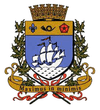Saint-Lambert, Quebec
| Saint-Lambert | |||
|---|---|---|---|
| City | |||
|
Downtown Saint-Lambert along Victoria Avenue | |||
| |||
|
Motto: Maximus in Minimus (Latin for "The greatest in the smallest detail.")[1] | |||
|
Location within the Urban Agglomeration of Longueuil | |||
 Saint-Lambert Location in southern Quebec | |||
| Coordinates: 45°30′N 73°31′W / 45.500°N 73.517°WCoordinates: 45°30′N 73°31′W / 45.500°N 73.517°W[2] | |||
| Country |
| ||
| Province |
| ||
| Region | Montérégie | ||
| RCM | None | ||
| Agglomeration | Longueuil | ||
| Founded | 1857 | ||
| Constituted | January 1, 2006 | ||
| Government[3][4] | |||
| • Mayor | Alain Dépatie | ||
| • Federal riding | Brossard—Saint-Lambert | ||
| • Prov. riding | Laporte | ||
| Area[3][5] | |||
| • Total | 10.10 km2 (3.90 sq mi) | ||
| • Land | 7.55 km2 (2.92 sq mi) | ||
| Population (2011)[5] | |||
| • Total | 21,555 | ||
| • Density | 2,853.5/km2 (7,391/sq mi) | ||
| • Dwellings | 10,419 | ||
| Time zone | EST (UTC−5) | ||
| • Summer (DST) | EDT (UTC−4) | ||
| Postal code(s) | J4P, J4R, J4S | ||
| Area code(s) | 450 and 579 | ||
| Highways |
| ||
| Website |
www | ||
Saint-Lambert is an off-island suburb of Montreal, Quebec, located on the south shore of the St. Lawrence River. It was home to 21,555 people according to the Canada 2011 Census.[5]
Saint-Lambert is divided into two main sections: the original city of Saint-Lambert and the Préville neighbourhood. The original city of Saint-Lambert (as it existed prior to 1969) is located from the Country Club of Montreal golf course to the border of Le Vieux-Longueuil borough. It includes the city's downtown, known as "The Village". On the other side of the Country Club of Montreal is the former city Préville, which merged with Saint-Lambert in 1969. It extends to the borders of the city of Brossard and the Longueuil borough of Greenfield Park.
Saint-Lambert was named for the early French Canadian hunter Lambert Closse.[6]
History
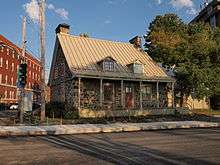
In 1636, Louis XIII of France was dividing up seigneuries in the new colony of New France. One of these was known as La Prairie, comprising La Prairie de la Magdeleine and La Prairie de Saint-Lambert. The lower part of the latter, was known as Mouillepied, due to the swampy conditions of the area. Saint-Lambert's first two permanent residents were André Marsil and André Achim in the 18th century. Today André Marsil's house can be found on the corner of Riverside Drive and Notre-Dame Avenue, was converted into a textile museum called the Marsil Museum (French: Musée Marsil), although the museum has since moved to the Bonsecours Market.
In 1722, Mouillepied was transferred from La Prairie seigneurie to Saint-Antoine-de-Longueuil parish.
Following the establishment of the railway in 1852 and the completion of the Victoria Bridge in 1859, the village received a permanent link to the island of Montreal. The Victoria Bridge, is the oldest bridge linking Montreal to the South Shore, and is the only rail line linking Quebec's largest city to New York City. Because of this, Saint-Lambert became an important passenger and freight stop for a long period of time. This is evident in the city's architecture, in which many old industrial buildings are found near the railway tracks. Many of these have since been converted into lofts such as the former Waterman pens factory, originally built in 1908.
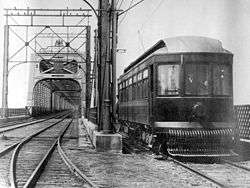
With the bridge and railway came a quick growth in Saint-Lambert's population and the construction of new housing. Saint-Lambert detached itself from Saint-Antoine-de-Longueuil and achieved municipality status in 1857, under its first mayor, Louis Bétournay. At the time, Saint-Lambert did not include Mouillepied, which instead had remained in Saint-Antoine-de-Longueuil.
In 1892, Saint-Lambert reached village status, attained town status in 1898 and city status in 1921.[6]
During World War I and World War II, Saint-Lambert had one of the highest military enlistment rates in Canada. The small city lost a total of 132 soldiers in both wars.[7] This number was a significant portion of the young people at the time.
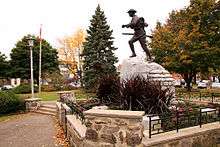
In the 1950s, the development of Saint-Lambert was enhanced with the building of the St. Lambert Locks in the St. Lawrence Seaway, to bypass the smaller Lachine Canal, and this became the most easterly lock in the Seaway. Suburban growth from Montreal in this period also affected Saint-Lambert, as well as many of the older communities on the South Shore.
Since its establishment, the city's limits have barely changed. In 1948, the old Mouillepied area of the town of Jacques-Cartier was split off and erected into the town of Préville. It merged with Saint-Lambert in 1969.
Saint-Lambert had an anglophone majority population starting in 1881, and throughout most of the 20th century. Saint-Lambert had 12,460 anglophones and was 61% anglophone as recently as the 1981 census.[9] This started to change, as it increasingly become the home to upper-middle class francophone families, in the 1970s, 80s and 90s.[6]
The late 1990s saw the construction of a new residential neighbourhood in Saint-Lambert, known as "Le Haut Saint-Lambert". It was built on the remaining vacant land in city limits near LeMoyne.
In 2007, the city of Saint-Lambert celebrated its 150th anniversary.
- Amalgamation and de-amalgamation
On January 1, 2002, municipal reorganization merged Saint-Lambert with LeMoyne to form a borough in the new Longueuil mega-city. There was a strong "de-merger" movement and a referendum was won on June 20, 2004, to re-establish the former city. The city was officially "re-born" on January 1, 2006, while on January 7, 2006, the Saint-Lambert flag was hoisted in front of city hall and the mayor, councillors and city manager took their oath of office.
Geography
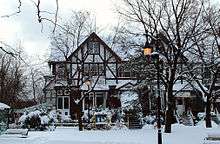
Saint-Lambert is underlain by Ordovician period black shale. This bedrock is covered by deep clay drift over most of the town. Soils were poorly drained in their natural state; as such, they were classified as gleysols—strongly acidic (Longueuil series) under most of the town and neutral to mildly alkaline (Boucherville series) in part of the western section (Préville).[10] Drainage and excavation have been used to adapt the soil for housing construction.
The most common trees in Saint-Lambert are those species which tolerate poor drainage. These include poplars, willows, red maple, silver maple and green ash. The American elm was formerly abundant but its population has been severely reduced by Dutch elm disease. Non-native species are commonly represented by Norway maple, silver birch, English oak, blue spruce, common horsechestnut and honey locust. Rare exotics which benefit from St-Lambert's favorable microclimate include Japanese maple and tulip tree. Most trees in Saint-Lambert show some evidence of damage from an ice storm in January 1998 and a severe thunderstorm in June 2008.
Climate
The climate of Saint-Lambert is characterized by abundant precipitation and one of the longest, warmest growing seasons in Quebec. As in other parts of Greater Montreal, lengthy spells of hot humid weather are common in summer. Thunderstorms are frequent and occasionally cause widespread damage. Heavy snow is usual in winter and several damaging ice storms have occurred over the town's history.
Demographics
| Historical populations | ||
|---|---|---|
| Year | Pop. | ±% |
| 1861 | 350 | — |
| 1871 | 327 | −6.6% |
| 1881 | 332 | +1.5% |
| 1891 | 906 | +172.9% |
| 1901 | 1,362 | +50.3% |
| 1911 | 3,334 | +144.8% |
| 1921 | 3,890 | +16.7% |
| 1931 | 6,075 | +56.2% |
| 1941 | 6,417 | +5.6% |
| 1951 | 8,719 | +35.9% |
| 1961 | 15,532 | +78.1% |
| 1971 | 18,616 | +19.9% |
| 1981 | 20,557 | +10.4% |
| 1991 | 20,976 | +2.0% |
| 1996 | 20,971 | −0.0% |
| 2001 | 21,051 | +0.4% |
| 2006 | 21,599 | +2.6% |
| 2011 | 21,555 | −0.2% |
| [9][11][12] | ||
As of the census of 2011, there were 21,555 people, 10,419 dwellings, and 5,680 families residing in the city.[5] The population density was 2,853.5 people per square kilometer (7,391/mi2).
Linguistically, as of the census of 2016, 73.34% of the population were native speakers of French, 12.64% English, 2.82% Spanish, 1.52% Arabic, 0.85% Romanian, 0.69% Persian, 0.66% Italian, 0.57% German, 1.59% both English and French, 0.36% French and a non-official language, 0.36% English and a non-official language, and 0.19% English, French and a non-official language.[13]
In the city the population was spread out with 15.1% under the age of 15, 9.8% from 15 to 24, 19.6% from 25 to 44, 29.2% from 45 to 64, and 26.3% who were 65 years of age or older. The median age was 48.5 years. 45% of the population is male, and 55% is female.[5]
As of the 2006 Census, the median income for a household in the city was $61,583, and the median income for a family was $89,786. The median income for the city was $36,293. About 11.9% of the population were low income, including 9.0% of those under age 18. The average value of an owned dwelling was $311,329.[14]
In terms of ethnic origin, 50.6% identified as Canadian, 39.6% French, 9.7% Irish, 7.8% English, 6.4% Scottish, 4.1% Italian, 3.7% German, 2.4% First Nations, 1.7% Belgian, 1.7% Spanish, and 1.6% Chinese.[15]
According to the 2001 census, there were 15,690 Roman Catholics in Saint-Lambert, who accounted for seventy-six percent of the population.[16] Additionally, there were 1,970 Protestants in Saint-Lambert in 2001, accounting for 9.5% of all residents.[16] The number of non-Christians in Saint-Lambert amounts to less than five percent of the population, and 9.6% of the population observe no religion whatsoever.[16]
Economy
Most of Saint-Lambert's commercial activity is based on Victoria Avenue, particularly on the part of the strip in the city's downtown (between Riverside Drive and the CN tracks), known as "the Village". This part of Victoria is most notably the location to the flagship of Taylor's department store. On this part of Victoria alone, there are around 44 businesses that sell durable and semi-durable goods; 22 cafés, bistros and restaurants and 960 street parking spaces. Around 50% of customers in the area come by automobile and 40% come by foot.[17]
Saint-Lambert is also home to Groupe Serdy, the owner of cable television specialty channels Évasion and Zeste. Roctest, a firm that specializes in making instrumentation for civil engineering projects also has its head office and factory in Saint-Lambert. Other notable Saint-Lambert businesses include Les Éditions Héritage book publisher and a Dare Foods (formerly Lido Biscuit) cookie factory.
Arts and culture
There are a handful of notable cultural institutions based in Saint-Lambert, such as Le Balcon d'Art and La Foire d'Art Contemporain de Saint-Lambert.
Saint-Lambert is also home to the Saint Lambert Municipal Memorial Library. It has two branches, the main branch is located on Mercille Avenue, and the other branch located in Préville.
Various large events take place annually in Saint-Lambert. One of these is Saint-Lambert Days, which takes place over a four-day period in late August and features live concerts and performances, games, and sidewalk sales.More than 80,000 people attend St. Lambert Days each year.[18]
There are three Roman Catholic churches in Saint-Lambert: Église catholique de St-Lambert and Église catholique Saint-Thomas-d'Aquin serve Francophone Catholics, and St. Francis of Assisi Catholic Church serves Anglophone Catholics. There are also five Protestant churches in Saint-Lambert which also serve neighbouring municipalities: St. Barnabas Anglican Church, St. Andrew's Presbyterian Church,[19] St. Lambert United Church, the South Shore Seventh-day Adventist Church and Good Shepherd Lutheran Church.
Government
Municipal
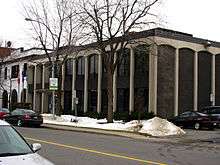
The mayor of the City of Saint-Lambert is Alain Dépatie. There are eight city councillors.[20]
| District | Councillor |
|---|---|
| 1 | Jean Bouchard |
| 2 | Martin Smith |
| 3 | Boris Chassagne |
| 4 | Dominique Lebeau |
| 5 | Jean-Pierre Roy |
| 6 | Hugues Létourneau |
| 7 | David Bowles |
| 8 | Martin Croteau |
Federal and provincial
Traditionally, the city of Saint-Lambert is predominantly federalist, specifically Liberal both federally and provincially. Despite this, in federal politics the riding tends to usually go in favour of the Bloc Québécois, because it includes a considerable portion of the more sovereigntist borough of Le Vieux-Longueuil in Longueuil.
The city of Saint-Lambert is located in the federal riding of Saint-Lambert, and its Member of Parliament is Sadia Groguhé of the New Democratic Party.
In provincial politics, Saint-Lambert forms part of the Laporte riding and its Member of the National Assembly is Nicole Ménard of the Quebec Liberal Party. The provincial riding is named after Pierre Laporte, a Quebec government cabinet minister who was kidnapped from outside his Saint-Lambert home and murdered by the Front de libération du Québec in the October Crisis of 1970.
Transport
- Roads
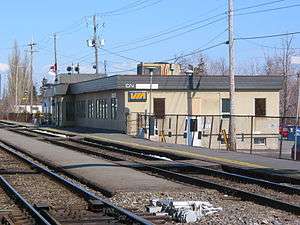
Saint-Lambert is served by the most important autoroute in Quebec province: Autoroute 20 . Saint-Lambert is also served by one of the most important provincial highway: Route 132. The Route 112 is also serving Saint-Lambert.
Important streets in Saint-Lambert include Victoria Avenue, Notre-Dame Street, Green Street, Desaulniers Boulevard, Riverside Drive, Sir-Wilfrid-Laurier Boulevard, Simard Boulevard and Tiffin Road.
In Saint-Lambert, two bridges link with Montreal (one to the Old Port and the other one, a bridge meant for bicycles, that connects to Île Notre-Dame). The Victoria Bridge links Saint-Lambert to Montreal Island. The Jacques Cartier Bridge in Longueuil is half a kilometre from Saint-Lambert and the Champlain Bridge in Brossard is a kilometre away from Saint-Lambert.
- Passenger rail
Via Rail serves Saint-Lambert railway station with its daily Montreal-Quebec City, Montreal-Gaspé and Montreal-Halifax trains.
Amtrak, the U.S. national passenger rail system, also provides daily service to Saint-Lambert railway station, operating its Adirondack in both directions between Montreal and New York City, using the Victoria Bridge.
Saint-Lambert railway station is also served by commuter rail on the Agence métropolitaine de transport's Mont-Saint-Hilaire Line.
- Transit
Bus service in Saint-Lambert is provided by the Réseau de transport de Longueuil. It is served by routes 1, 2, 6, 13, 14, 15, 37. 54. 55, 106 and 115. Bus service was originally provided by Chambly Transport as well as the Commission de Transport de la Communauté Urbaine de Montréal.
Interurban streetcar service was operated until 1956 by the Montreal and Southern Counties Railway.
Education

The highest level of the educational facilities in Saint-Lambert is the public anglophone CEGEP with 2,500 students, Champlain College Saint-Lambert which also houses an office for Université du Québec à Montréal. The Commission Scolaire Marie-Victorin has jurisdiction over three French language primary schools in Saint-Lambert, École Des Saints-Anges, École Rabeau and Préville Elementary.
Collège Durocher Saint-Lambert is a large French language private school and is therefore not affiliated with any school board. It consists of two campuses, the Saint-Lambert Campus on the corner of Riverside and Notre-Dame Avenue as well as the Durocher Campus on the corner of Riverside and Tiffin Road, opposite Champlain Regional College.
The English language Riverside School Board operates five schools on Saint-Lambert's territory. The most notable of these is the IB-accredited Chambly Academy which is home to over five-hundred students from Grade 7-Grade 11. The other secondary school that the board operates in the city is The Alternate School which is meant to reintegrate at-risk youth into mainstream society. St. Lambert Elementary School serves Kindergarten to Grade 6, and also houses around five-hundred students. Intellectually disabled students are served by REACH School as well as a program at Chambly Academy geared toward their academic success. ACCESS Continuing Education and Career Training Centre is an adult education institution, helping adults and immigrants get high school diplomas.
The South Shore Protestant Regional School Board previously served the municipality.[21]
Sports

Saint-Lambert is home to the St. Lambert Locks RFC men's and women's rugby union teams, which belong to Rugby Quebec. It is also represented by the Blue Machine swimming team.[22]
At the intercollegiate level, St. Lambert is represented by the Champlain College Saint-Lambert Cavaliers, which field both men's and women's teams in badminton, basketball, cross country running, Canadian football, rugby union, soccer and volleyball.[23] Both of Saint-Lambert's secondary schools also field teams.[24]
Saint-Lambert is also home to several sports venues including the Eric Sharp Arena, an indoor swimming pool and a recreation centre. It also has several outdoor athletics facilities situated in parks.[25]
Media
The city of Saint-Lambert is home to one weekly newspaper, the bilingual St-Lambert Journal. It is also served by two regional French-language weekly newspapers, Le Courrier du Sud and Rive-Sud Express, which are based out of neighbouring Longueuil.
Notable natives and residents
|
|
Partner cities
-
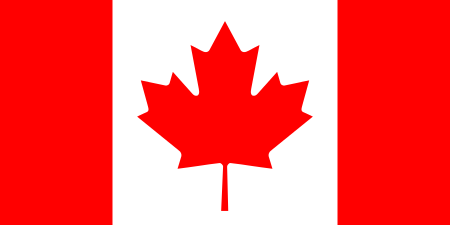 Vernon, British Columbia, Canada [28]
Vernon, British Columbia, Canada [28] -
 Marblehead, Massachusetts, United States [29][30]
Marblehead, Massachusetts, United States [29][30] -
 La Flèche, Pays de la Loire, France[31]
La Flèche, Pays de la Loire, France[31]
See also
- List of cities in Quebec
- Municipal reorganization in Quebec
- Urban agglomeration of Longueuil
- Ville LeMoyne
References
- ↑ "Ville de Saint-Lambert". The Public Register of Arms, Flags and Badges of Canada. Governor General of Canada. 2004-02-25. Retrieved 15 January 2010.
- ↑ Reference number 388455 of the Commission de toponymie du Québec (in French)
- 1 2 Ministère des Affaires municipales, des Régions et de l'Occupation du territoire: Saint-Lambert
- ↑ Parliament of Canada Federal Riding History: SAINT-LAMBERT (Quebec)
- 1 2 3 4 5 "Census Profile — Saint-Lambert, Ville". Canada 2011 Census. Statistics Canada. 2012-02-08. Retrieved 9 February 2012.
- 1 2 3 "Portrait and history". City of Saint-Lambert. Retrieved 13 October 2013.
- ↑ Montreal Gazette Article
- ↑ "Stolen plaque replaced in St. Lambert". Canada.com. Montreal Gazette. Retrieved 24 January 2015.
- 1 2 Pratt, Michel. "Les paroisses au XIXe siècle". Société historique et culturelle du Marigot. Retrieved 24 October 2013.
- ↑ http://sis.agr.gc.ca/cansis/publications/pq/pq12a/index.html Roger Baril and A. Mailloux. Soil Map and Legend of Chambly County (1942).
- ↑ Pratt, Michel. "De la balkanisation des villes à leur fusion". Société historique et culturelle du Marigot. Retrieved 24 October 2013.
- ↑ Statistics Canada: 1996, 2001, 2006, 2011 census
- ↑
- ↑ 2006 Statistics Canada Community Profile: Saint-Lambert, Quebec
- ↑ Ethnocultural Portrait of Canada Highlight Tables: St. Lambert
- 1 2 3 Statistics Canada - Saint-Lambert 2001 Community Profile.
- ↑ "Village Sector (downtown)". Corporation for the Commercial Development of Saint-Lambert. Retrieved 26 February 2010.
- ↑ "Saint-Lambert Days" (PDF). Ville de Saint-Lambert. 2009. Retrieved 24 June 2010.
- ↑ St. Andrew's Presbyterian Church
- ↑ "City Council Members". Saint-Lambert, Quebec: City of Saint-Lambert. 11-09. Retrieved 20 November 2009. Check date values in:
|date=(help) - ↑ King, M.J. (Chairperson of the board). "South Shore Protestant Regional School Board" (St. Johns, PQ). The News and Eastern Townships Advocate. Volume 119, No. 5. Thursday December 16, 1965. p. 2. Retrieved from Google News on November 23, 2014.
- ↑ "Blue Machine". Retrieved 10 July 2012.
- ↑ "Champlain Cavaliers Athletics". Champlain College Saint-Lambert. Retrieved 20 May 2013.
- ↑ "L'Impact — Toutes les infos, tous les résultats et toutes les activités sportives du CDSL". Retrieved 10 July 2012.
- ↑ "St-Lambert Sports". Retrieved 23 April 2012.
- ↑ 1980 NHL Entry Draft—Steve Kasper
- ↑ CSA - Official Flying Kit
- ↑ City of Vernon, British Columbia
- ↑ Marblehead, Massachusetts Youth Hockey Program
- ↑ Gasper, Christopher L. (2004-11-21). "2 teams, 1 goal: esprit de corps". The Boston Globe. Retrieved 2008-07-26.
- ↑ "Echanges internationaux" (in French). La Flèche, France: Ville de La Flèche. Retrieved 31 January 2014.
External links
| Wikimedia Commons has media related to Saint-Lambert, Montérégie, Quebec. |
_2014.jpg)

